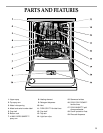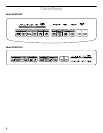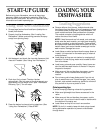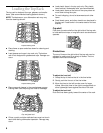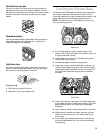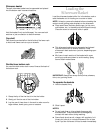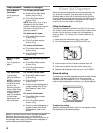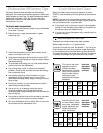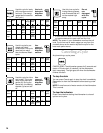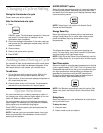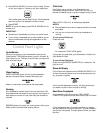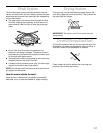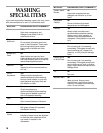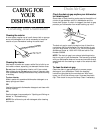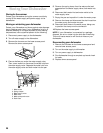
13
Dishwasher Efficiency Tips
Hot water dissolves and activates the dishwashing
detergent. Hot water also dissolves grease on dishes and
helps glasses dry spot-free. For best dishwashing results,
water must be at least 120°F (49°C) as it enters the
dishwasher. Loads may not wash as well if the water
temperature is too low.
To check water temperature
1. Run hot water at the faucet closest to your dishwasher
for at least 1 minute.
2. Place a candy or meat thermometer in a glass
measuring cup.
3. Check the temperature on the thermometer as the
water is running into the cup.
4. If the water temperature at the faucet is below 120°F
(49°C), have a qualified person raise the water heater’s
thermostat setting.
■ To save water and energy, do not rinse dishes before
putting them into the dishwasher.
■ Use a low energy, quick, or short cycle whenever
possible. These cycles use less hot water and energy
than the Normal cycle.
■ Use a delay feature (on some models) to run your
dishwasher during off-peak hours. Local utilities
recommend avoiding heavy usage of energy at certain
times of day.
■ During the summer, run your dishwasher at night to
reduce daytime heat buildup.
■ Use an air dry, or an energy-saving dry option
whenever possible. Allow longer drying times
(overnight) when using these options. Use a rinse aid to
improve drying.
■ Use cycles or options that add extra heat to the wash
or rinse portion of the cycle only when needed.
■ Run your dishwasher with full loads. Run a rinse cycle
after meals until the dishwasher is full.
Cycle Selection Chart
Select the wash cycle and options desired. Or press
START to use the same cycle and options as the previous
cycle.
NOTE: If the last cycle you completed was a rinse cycle,
the dishwasher will run the last full wash cycle and options
that you selected when you press Start.
■ If the power is off or the door is open for an extended
period of time, the Start button memory will default to
the Normal cycle with heated drying.
■ If you do not run the dishwasher daily, close the door to
maintain memory.
A “
●
” shows what steps are in each cycle.
Temperatures indicate where extra heat is added.
Water usage is shown in U.S. gallons/liters.
Cycle time includes dry time. An asterisk ( * ) by the cycle
time indicates the cycle time might be longer depending
on the temperature of the water entering the dishwasher.
The cooler the water, the longer the cycle time. If the water
is already hot enough, the cycle time will be as shown.
Soil
Level
Sensed
Pre-
Wash
Rinse Main
Wash
Rinse Final
Heated
Rinse
Dry Time
(min)
Water
Usage
(gal/L)
Heavy
●
●●
●●
●●
●●
●●
●
140°F
(60°C)
●
●●
●●
●●
●
155°F
(68°C)
●
●●
●
97* 10.8/
40.9
Light
●
●●
●
135°F
(57°C)
●
●●
●
140°F
(60°C)
●
●●
●●
●●
●
155°F
(68°C)
●
●●
●
87* 8.6/32.7
Soil
Level
Sensed
Pre-
Wash
Rinse Main
Wash
Rinse Final
Heated
Rinse
Dry Time
(min)
Water
Usage
(gal/L)
Heavy
●
●●
●●
●●
●●
●●
●
140°F
(60°C)
●
●●
●●
●●
●
140°F
(60°C)
●
●●
●
92* 10.8/
40.9
Light
●
●●
●
135°F
(57°C)
●
●●
●
140°F
(60°C)
●
●●
●●
●●
●
140°F
(60°C)
●
●●
●
82* 8.6/32.7
This cycle is the most
aggressive cycle to
virtually eliminate
bacteria from your dish
load. Use this cycle for
hard-to-clean, heavily
soiled pots, pans,
casseroles and regular
tableware.
Use both
detergent
dispenser
sections.
Use this cycle for hard-
to-clean, heavily-soiled
pots, pans, casseroles,
regular tableware and
harder than normal
water conditions.
Use both
detergent
dispenser
sections.



